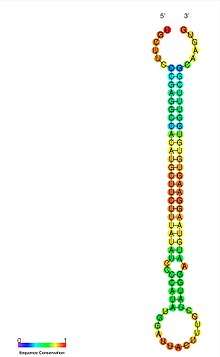MiR-206


MiR-206 is a microRNA that in humans is a member of the myomiR family which also includes miR-1, miR-133, miR-208a/b among few others.[1][2][3][4]
As well as being regulated during the embryonic development of skeletal muscle, miR-206 is regulated by estradiol.[5][6] C2C12 myoblast cells are widely used as a model for the study of cell differentiation in skeletal muscle. Furthermore, miR-206 is highly expressed in triple-negative breast tumors that grow independent of estradiol, and miR-206 is a predictor of worse overall survival in breast cancer patients.[7]
The biogenesis of miR-206 is unique in that the primary mature transcript is generated from the 3p arm of the precursor hairpin rather than the 5p arm.[8] miR-206 has 12 additional family members, whereby the seed sequence is 100% conserved across all miRNAs within the family.
Single nucleotide polymorphisms (SNPs) are also present in the miRNA sequence, some of them with functional consequences, in the sense that the efficiency of miRNA binding to a cognate mRNA target is altered depending on a single nucleotide substitution.[9] In fact a number of studies have indicated that the canonical seed sequence of a miRNA is not longer the sole determinate in miRNA:mRNA pairing interactions, as mutations of residues outside the seed region alters binding efficacy.
miR-206 is of interest due to the continued detection of this miRNA in samples from those with type 2 diabetes and non-alcoholic fatty liver disease (NAFLD). In some studies the therapeutic delivery of miR-206 in a dietary obese mouse model resulted in reduced lipid and glucose production within the liver. The ability of miR-206 to facilitate insulin signaling and modulate lipogenesis indicates miR-206 may be a novel therapy for those with hyperglycemia.[10]

References
- ↑ Sempere LF, Freemantle S, Pitha-Rowe I, Moss E, Dmitrovsky E, Ambros V (2004). "Expression profiling of mammalian microRNAs uncovers a subset of brain-expressed microRNAs with possible roles in murine and human neuronal differentiation". Genome Biology. 5 (3): R13. doi:10.1186/gb-2004-5-3-r13. PMC 395763. PMID 15003116.
- ↑ van Rooij E, Quiat D, Johnson BA, Sutherland LB, Qi X, Richardson JA, Kelm RJ, Olson EN (November 2009). "A family of microRNAs encoded by myosin genes governs myosin expression and muscle performance". Developmental Cell. 17 (5): 662–73. doi:10.1016/j.devcel.2009.10.013. PMC 2796371. PMID 19922871.
- ↑ Small EM, O'Rourke JR, Moresi V, Sutherland LB, McAnally J, Gerard RD, Richardson JA, Olson EN (March 2010). "Regulation of PI3-kinase/Akt signaling by muscle-enriched microRNA-486". Proceedings of the National Academy of Sciences of the United States of America. 107 (9): 4218–23. doi:10.1073/pnas.1000300107. PMC 2840099. PMID 20142475.
- ↑ van Rooij E, Sutherland LB, Qi X, Richardson JA, Hill J, Olson EN (April 2007). "Control of stress-dependent cardiac growth and gene expression by a microRNA". Science. 316 (5824): 575–9. doi:10.1126/science.1139089. PMID 17379774.
- ↑ Adams BD, Furneaux H, White BA (May 2007). "The micro-ribonucleic acid (miRNA) miR-206 targets the human estrogen receptor-alpha (ERalpha) and represses ERalpha messenger RNA and protein expression in breast cancer cell lines". Molecular Endocrinology. 21 (5): 1132–47. doi:10.1210/me.2007-0022. PMID 17312270.
- ↑ Adams BD, Cowee DM, White BA (August 2009). "The role of miR-206 in the epidermal growth factor (EGF) induced repression of estrogen receptor-alpha (ERalpha) signaling and a luminal phenotype in MCF-7 breast cancer cells". Molecular Endocrinology. 23 (8): 1215–30. doi:10.1210/me.2009-0062. PMC 2718747. PMID 19423651.
- ↑ Kondo N, Toyama T, Sugiura H, Fujii Y, Yamashita H (July 2008). "miR-206 Expression is down-regulated in estrogen receptor alpha-positive human breast cancer". Cancer Research. 68 (13): 5004–8. doi:10.1158/0008-5472.CAN-08-0180. PMID 18593897.
- ↑ Kozomara A, Griffiths-Jones S (January 2014). "miRBase: annotating high confidence microRNAs using deep sequencing data". Nucleic Acids Research. 42 (Database issue): D68–73. doi:10.1093/nar/gkt1181. PMC 3965103. PMID 24275495.
- ↑ Grimson A, Farh KK, Johnston WK, Garrett-Engele P, Lim LP, Bartel DP (July 2007). "MicroRNA targeting specificity in mammals: determinants beyond seed pairing". Molecular Cell. 27 (1): 91–105. doi:10.1016/j.molcel.2007.06.017. PMC 3800283. PMID 17612493.
- ↑ Wu H, Zhang T, Pan F, Steer CJ, Li Z, Chen X, Song G (April 2017). "MicroRNA-206 prevents hepatosteatosis and hyperglycemia by facilitating insulin signaling and impairing lipogenesis". Journal of Hepatology. 66 (4): 816–824. doi:10.1016/j.jhep.2016.12.016. PMC 5568011. PMID 28025059.